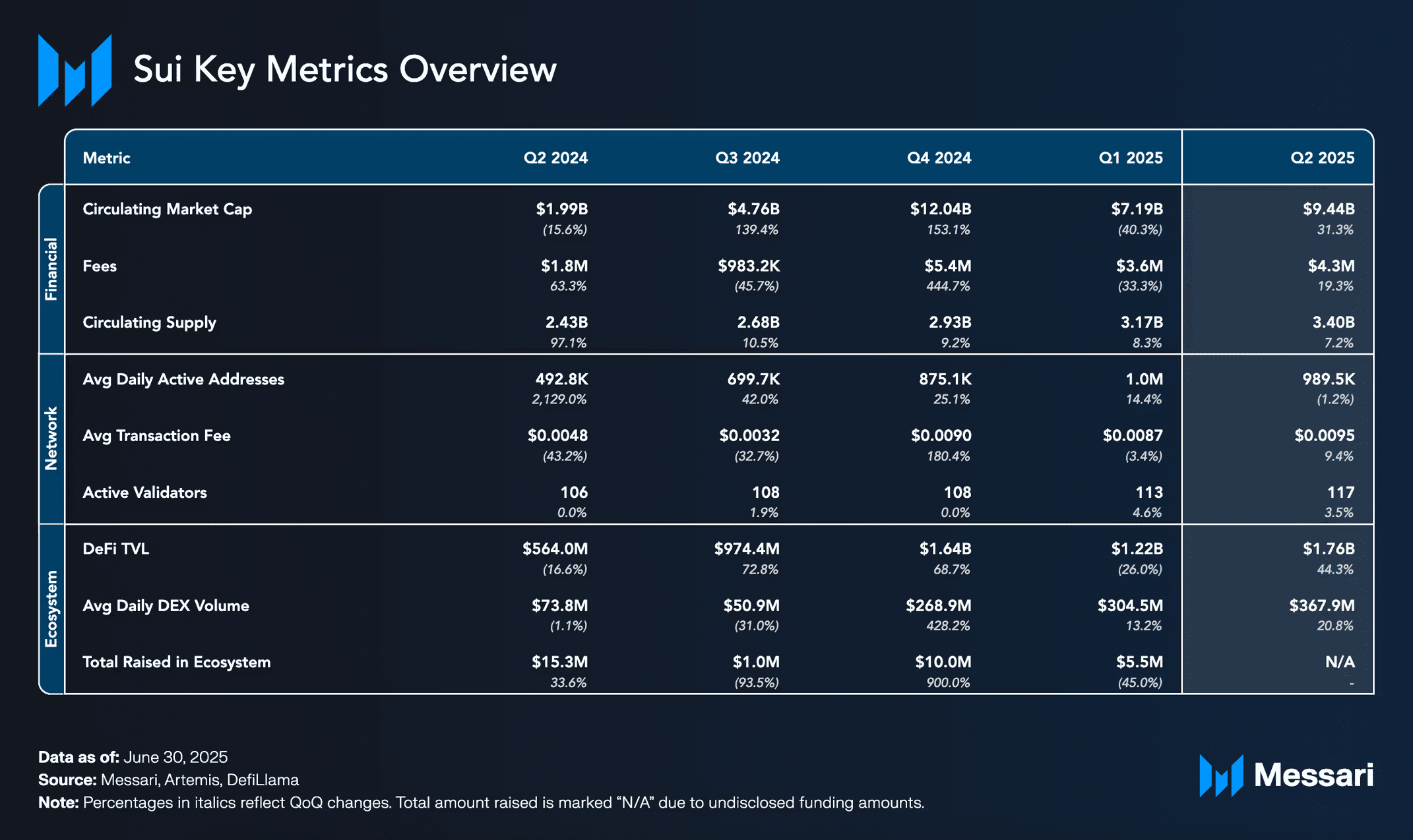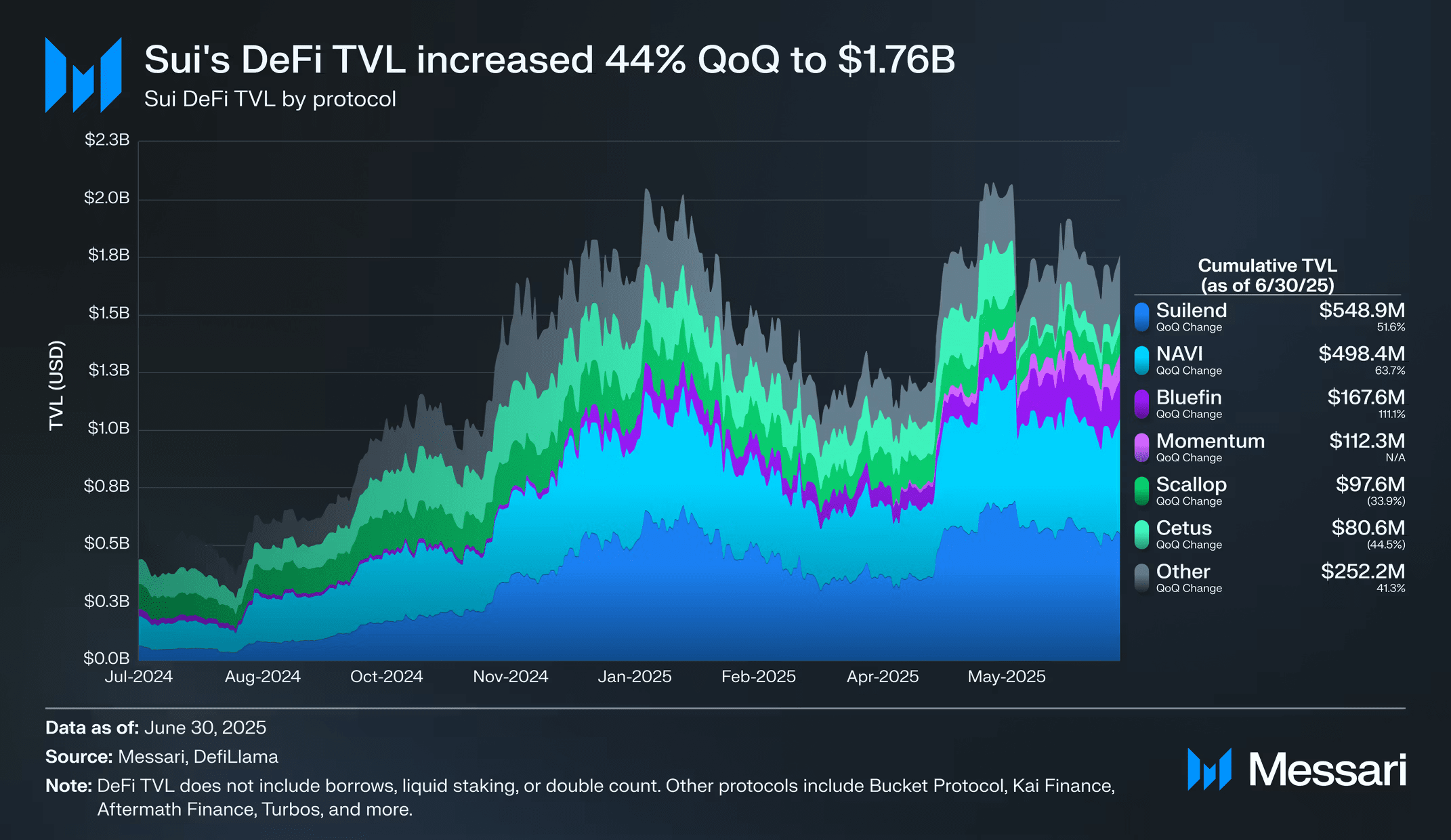In the broader cryptocurrency market picture of 2025, Sui Network (SUI) stands out as one of the fastest-growing blockchain ecosystems. While the 2023–2024 period witnessed a strong rise of Ethereum Layer 2 and new generation Layer 1 blockchains, stepping into 2025, Sui is gradually asserting its own position by combining expanding DeFi liquidity, widespread interest from financial institutions, and notable advancements in Web3 infrastructure.
It is noteworthy that the growth of Sui does not solely stem from token price factors but also reflects real demand for products and services within the ecosystem – an important sign that the project has the potential for sustainable development.
DeFi: The growth pillar of Sui in Q2 2025
According to the latest report from Messari, Q2 2025 marks a significant turning point as the Sui ecosystem sets a series of records in the DeFi space. The average daily DEX trading volume reached $367.9 million, an increase of 20.8% compared to the previous quarter – an impressively notable figure in the context of the cryptocurrency market, which is generally recovering at a moderate pace. Notably, two key protocols, Cetus and Bluefin, have become the main growth drivers, contributing $170.7 million and $78.5 million daily, respectively. This shows that Sui is not only expanding liquidity but also forming strategic trading hubs capable of retaining long-term capital.

At the same time, the total value locked (TVL) of Sui has increased by 44.3% to $1.76 billion. When calculated in SUI, TVL also increased from 536.6 million to 631.8 million SUI, corresponding to 17.7%. This is a key detail: the increase in TVL does not simply stem from token price fluctuations but reflects the real capital committed and locked within the ecosystem. In other words, investors are not just 'short-term betting' but are trusting in the profitability and safety of the DeFi protocols on Sui.
This growth rate is particularly important when placed in the context of competition among L1 blockchains. One of the biggest barriers for new platforms is building core liquidity – a crucial factor determining the ecosystem's attractiveness to both users and developers. Ethereum maintains its dominant position thanks to deep liquidity, Solana breaks through due to fast processing capabilities and attracting DeFi capital, while many other L1s still struggle with limited liquidity issues. Sui, with strong growth in Q2, has demonstrated the ability to overcome this barrier, laying the groundwork for direct competition with major market players.

Financial institutions: A turning point for the legitimacy of Sui
One of the most significant signs in Q2 2025 is the increasingly deep participation of global financial institutions in the Sui ecosystem. This is not only a recognition of the technology but also a legitimate turning point that helps Sui step out of the scope of a nascent blockchain to become a platform with a position in the international market.
First of all, Grayscale – one of the largest digital asset management funds in the world – has launched DeepBook Trust and Walrus Trust. These products are directly focused on the core assets within the Sui ecosystem, showing that Grayscale not only views Sui as a short-term speculative play but also sees it as an ecosystem with long-term growth potential and sufficient liquidity to create specialized financial products. Typically, Grayscale selectively chooses impactful blockchains with strong communities; hence this move is an indirect confirmation of Sui's rising position.
Along with that, 21Shares, a leading ETP issuer in Europe, has officially applied for a SUI ETF in the US. If approved, this will be a historical milestone, opening the door for a massive influx of traditional capital from pension funds, insurance companies, and US institutional investors to directly participate in SUI. ETFs are not just trading instruments but also serve as a bridge between traditional finance (TradFi) and digital assets, thereby enhancing liquidity and market acceptance of this blockchain.
Meanwhile, Fireblocks, one of the leading digital asset custody and security platforms, has integrated Sui into its service system. This is a strategically significant step: to attract institutional capital, a blockchain must ensure secure asset custody, compliance with legal regulations, and integration with existing banking and investment fund systems. Fireblocks provides exactly those factors, from risk management to security solutions, helping financial institutions confidently deploy capital on Sui without encountering technical or legal barriers.
Overall, these advancements have created a layer of confirmation from institutions – considered a 'seal of approval' regarding the reliability and long-term potential of a blockchain. With backing from major institutions, Sui not only enhances its reputation in the market but also builds a solid foundation for long-term institutional capital, a key factor helping the ecosystem avoid short-term explosive growth followed by a downturn – a scenario that has occurred with many other L1 blockchains.
Web3 Infrastructure: The foundation for scaling up
In tandem with the strong growth in DeFi and the increasingly deep participation of institutional capital, Sui Network is also focusing on building Web3 infrastructure – an element considered the 'backbone' for scaling the ecosystem in the long term. Instead of relying solely on liquidity or TVL like many other L1 blockchains, Sui is pursuing a multi-pillar strategy where technical infrastructure becomes a sustainable competitive advantage.
One of the notable highlights is Mysten Labs introducing Seal, a decentralized secret management solution currently in testing on the testnet. This technology not only adds an enhanced data security layer but also opens up practical application possibilities for Web3 products requiring high privacy and security, such as enterprise financial transactions, personal information storage, or smart contracts in the healthcare sector. This is an area that many major blockchains still overlook, allowing Sui to differentiate itself in the 'security race' of Web3.
In the stablecoin sector, two major exchanges, MEXC and Kraken, have begun supporting native USDC on Sui. This brings strategic implications: when stablecoin capital can move directly from CeFi to DeFi on Sui, users will benefit from lower costs, faster speeds, and reduced risks. This is crucial, as stablecoins currently play a central role in all DeFi activities, from providing liquidity to derivative trading.
Additionally, the Sui ecosystem has significantly expanded thanks to important integrations:
Ledger and Trust Wallet strengthen custody capabilities, enhancing security for both individual and institutional assets.
Axelar and Backpack promote cross-chain interaction, ensuring that assets can move seamlessly between Sui and other blockchains – one of the essential requirements to attract global capital flows.
Privy and Microsoft Fabric pave the way for enterprise data mining, taking blockchain beyond traditional decentralized finance to connect with real-world applications in enterprises, from data governance to supply chain management.
The combination of these advancements shows that Sui is not merely a platform focused on DeFi but is gradually evolving into a comprehensive Web3 ecosystem, where decentralized finance, data security, and enterprise applications can coexist. This strategy enables Sui to not only compete with L1s in terms of liquidity but also to expand its application space beyond pure cryptocurrency – a factor that could determine its leading position in the Web3 era.
Price movements and market capitalization of SUI: Opportunities still open
Q2 2025 marks a remarkable growth phase for SUI as the circulating market capitalization reaches $12.3 billion, an increase of 31.3% compared to the previous quarter. This figure far exceeds the average growth of 23.5% across the entire cryptocurrency market, indicating that capital is prioritizing a strong influx into Sui compared to the general market.

The price of SUI is currently trading around $3.46, a slight increase of 1% in the past 24 hours. Nevertheless, this token is still about 34% lower than its all-time high (ATH), reflecting two notable points:
The attraction of capital even before returning to the old peak: The strong growth in market capitalization demonstrates that investors are not only seeking short-term profits from price fluctuations but are increasingly viewing SUI as a strategic asset with long-term growth potential. This is an important distinction, as most new blockchains typically only attract capital when prices approach or exceed ATH.
The growth potential is still very large: The 34% gap from the old peak can be seen as a 'potential area' that has not been fully exploited. In the context of the cryptocurrency market recovering, SUI's ability to maintain capital attraction even before re-establishing its peak reinforces the belief that this token can accelerate strongly once market trends return to a state of excitement.
In summary, with outstanding growth in market capitalization, prices still far from ATH, and institutional capital beginning to flow in, SUI is in a unique position: proving its appeal in the present while possessing a wide-open growth potential for the future.
Prospects for the next 6–12 months
Based on current dynamics, the prospects for Sui Network in the second half of 2025 and early 2026 can be assessed through three main scenarios:
Positive scenario: If the SUI ETF in the US is approved and institutional capital continues to flow strongly into the ecosystem, Sui could have the opportunity to break back to the peak region. In this case, the price of SUI could approach the ATH level, while TVL is likely to exceed $2.5 billion. This would be a 'double boost' scenario, where both macro factors (ETF, institutional capital flows) and internal factors (DeFi liquidity, native stablecoins, Web3 infrastructure) resonate simultaneously.
Neutral scenario: Sui maintains growth rates in DeFi and infrastructure but without any significant macro boost. At that point, the price of SUI may fluctuate in the range of $3–$4.5, with stable growth margins but not enough to create an explosion. TVL will continue to increase steadily, reflecting intrinsic attractiveness, but will not reach a breakout growth level. This scenario reflects the general state of the cryptocurrency market, which is in a period of accumulation or sideways movement.
Negative scenario: If the global crypto market weakens – for example, due to tightening monetary policy or liquidity fluctuations – or if institutional capital flows reverse, Sui could face downward pressure on prices. In this scenario, TVL may stagnate or decline, but Sui still has the potential to maintain its position as a leading L1 blockchain, thanks to its infrastructure and community support.
In summary, Sui Network is gradually becoming a new force in the blockchain ecosystem, with advantages stemming from impressive TVL growth, backing from major institutions, developing Web3 infrastructure, and the ability to attract native stablecoin capital. These factors help Sui not only have the potential to overcome short-term correction periods but also open up opportunities to advance further, becoming a direct competitor to Ethereum, Solana, and other major L1 blockchains in the race for the central position in global DeFi and Web3.
